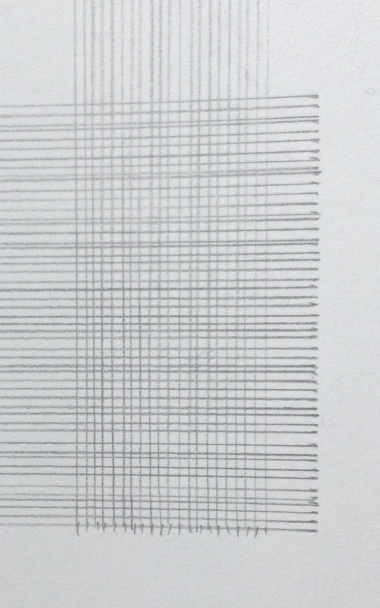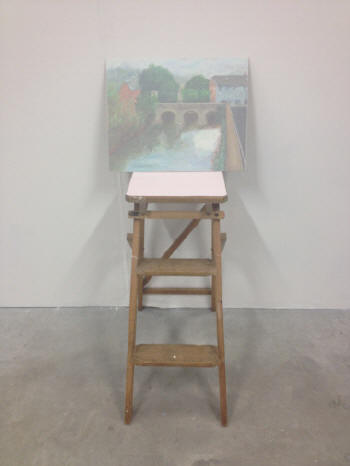|
Megan
Calver: LOVE RULES OK Susie David
 Before
you go in you notice the glass doors have been very thinly white washed
as if to slightly obscure the exhibition inside. Shops do this when
they're doing something inside that they don't want you to see, but here
it is only a faint wash - a veil, which has broken in places into a
delicate filigree. You can see through, but you have to really look. You
are invited to ‘declare your love’ by drawing on the glass. There is a
heart, names, initials and a few random marks. Megan Calver likes them:
“they are a sort of love message too”. Everything here is a token, a
message, of love. Before
you go in you notice the glass doors have been very thinly white washed
as if to slightly obscure the exhibition inside. Shops do this when
they're doing something inside that they don't want you to see, but here
it is only a faint wash - a veil, which has broken in places into a
delicate filigree. You can see through, but you have to really look. You
are invited to ‘declare your love’ by drawing on the glass. There is a
heart, names, initials and a few random marks. Megan Calver likes them:
“they are a sort of love message too”. Everything here is a token, a
message, of love.
There is a twig that had been dropped by two pigeons whilst being passed
from beak to beak, now it is held by the beaks of two clothes pegs as it
hovers still in the air, poking out of the wall as if the story
continues out of sight on the other side.
Three measuring rules, or rulers, given to her by her grandfather, her
father and her daughter initiated these process-based investigations in
which Calver began by exploring the rulers’ functions and how they
demanded to be used - she had to discover their set of ‘rules’. She says
of this first stage: “I began by wanting to touch every calibration that
my grandfather and father would have touched, using repetition and
copying to keep an emotional response in check.” Her grandfather died
some twenty odd years ago. Her father is becoming very ill. Her daughter
has moved away for her work.
 So
the drawing of the lines with a fine mechanical pencil began - each
repeated reverentially and tenderly, carried out according to the rulers
increments and capabilities in order to draw lines or grids. So
the drawing of the lines with a fine mechanical pencil began - each
repeated reverentially and tenderly, carried out according to the rulers
increments and capabilities in order to draw lines or grids.
Calver talks about the oddness of using Skype to communicate with her
daughter. Her daughter, a writer, had given her a rolling ruler that is
designed to help draw lines parallel to one another. She explains: “The
conceit is that I’d make these lines for her to write on, but they’re
too tight. Maybe I’m talking too much and she can’t get a word in
edgeways?” Perhaps the drawing implies the between-the-lines-writing
that could be done, or perhaps the lines speak of closing the distance
between them.
On a piece of marker
paper using the ruler from her mathematician father, Calver attempted to
make a premium piece of graph paper by following the guides. She glances
askance at her graph paper: “It’s laughing at me”. After the first
attempt she went to visit her father and she realised she had to do it
again: “it was too hard. The line needed to be lighter. The emotion was
affecting the weight of the pencil”. For in amongst all this repetition,
strict line-following, rule-abiding and regimented line-drawing, there
is a softness she is searching for. She is hoping for something other to
show through.
 On
one sheet of A4 paper a pair of inverted commas have been drawn in very
fine repeated pencil lines, so that each curve is slightly shifted from
the next and two arcs of crescents result. These have been reversed
slightly obliquely on the other side of the paper and they ghost
through. The edges of the paper curl up slightly, encouraging you to
lift the page and see the other side. On
one sheet of A4 paper a pair of inverted commas have been drawn in very
fine repeated pencil lines, so that each curve is slightly shifted from
the next and two arcs of crescents result. These have been reversed
slightly obliquely on the other side of the paper and they ghost
through. The edges of the paper curl up slightly, encouraging you to
lift the page and see the other side.
A painting by her grandfather, a carpenter by trade, is perched on top
of a small step ladder topped with flesh-pink felt - which makes a
subliminal link to Beuys’ rest-orative felt and fat. The felt softens
the utilitarian nature of the step ladder and makes it a gentle perch
for this precious object. The painting is further protected by being
shrouded in tracing paper, which may be lifted to see beneath. The
protection may be from any harsh gazes that casually ricochet around an
art school (where this exhibition is housed). There are signs that a
ruler was used in the painting’s making.
On a nearby wall there are two pieces of A4
black-edged card upon which seemingly inconsequential parts of the
painting, a patch of water say, where the light hits, have been
transferred with the most delicate of fragile, shaking lines. This pale
knotted tracery dances off-centre on each sheet. They are achingly
exquisite. “These are beautiful” says Calver “to stop people in their
tracks - to make them look”.
Looking at her works is always rewarding. Many are made whilst
attempting apparently impossible tasks, and a further performative
element involves endurance, in the spirit of Bergson’s durée, rather
than duress.
 She
remembers her grandmother in cafés, and the way she would save her paper
serviette, smoothing it out to be re-used later, sometimes offering it
to her grand-daughter as a hanky (another love token). In homage Calver
set about exploring this gesture by repeatedly crumpling up and
smoothing out a single paper serviette over a period of 24 hours. She
remembers her grandmother in cafés, and the way she would save her paper
serviette, smoothing it out to be re-used later, sometimes offering it
to her grand-daughter as a hanky (another love token). In homage Calver
set about exploring this gesture by repeatedly crumpling up and
smoothing out a single paper serviette over a period of 24 hours.
For display, the serviette’s three layers have
been carefully peeled apart, a form of emotional dissection, and each
then draped over its own cut-glass cutlery rest, which animates the
scene with motes of light glinting in the facets. All three mounds lie
on a plain Ikea trestle table covered neatly with the same pale flesh-pink
felt as before. The tissue paper is so worn, so smoothed, …so loved! At
first sight it could be the most delicate lace, it could have been made,
or tatted, by her grandmother. Each see-through and delicate ply lies
there in its fragile, vulnerable state, exposed to gusts of wind or an
over-curious viewer’s clumsy touch.
Focussed on simple repetitive tasks arising from specific sets of tools
and apparatus given as love tokens, Calver searches for closeness. It
became evident to me that each of the many lines in the exhibition is
attempting to span the distance between the artist and her loved ones,
to calibrate and to celebrate emotion. This strategy is not a measure of
love but a marking of its increments, through the time and the
 distance
that has accrued between. In a world that seems too hard, too governed
by rules, the artist works through these rules in order to arrive at the
inverse: softness of emotion. This journey, through the dictates of
apparatus and routine, is a form of longing, that hopes to arrive
through her love to their love, on the other side. distance
that has accrued between. In a world that seems too hard, too governed
by rules, the artist works through these rules in order to arrive at the
inverse: softness of emotion. This journey, through the dictates of
apparatus and routine, is a form of longing, that hopes to arrive
through her love to their love, on the other side.
For, in all these works, you can see through and catch glimpses of
things behind or on the other side - through the door, the paper, the
tracing paper, the serviette. Although all these works are left
vulnerable, with no frames or display cases, nevertheless they appear
cocooned from the harsh world: by the wash on the windows, the cut-glass
rests, the sheets of tracing paper, and the cushioning felt. Calver
laments: “There is so much horrific stuff going on in the world”.
She moves a thin white carpenter’s folding rule from one wall to
another, trying several times to prop it between the wall and the
slippery floor where small orange adhesive spots have been placed to mark
potential places of rest. “Does love rule? I don’t know” she sighs
wistfully. The spots give just the merest hint of purchase, enough to
hold the ruler as it curves like a cupid’s bow about to spring.
LOVE RULES OK Process drawings generated from familial
objects Megan Calver
22 September - 3 October 2014 Artspace, 101 Roland Levinsky Building,
Plymouth University
|



 On
one sheet of A4 paper a pair of inverted commas have been drawn in very
fine repeated pencil lines, so that each curve is slightly shifted from
the next and two arcs of crescents result. These have been reversed
slightly obliquely on the other side of the paper and they ghost
through. The edges of the paper curl up slightly, encouraging you to
lift the page and see the other side.
On
one sheet of A4 paper a pair of inverted commas have been drawn in very
fine repeated pencil lines, so that each curve is slightly shifted from
the next and two arcs of crescents result. These have been reversed
slightly obliquely on the other side of the paper and they ghost
through. The edges of the paper curl up slightly, encouraging you to
lift the page and see the other side. 
